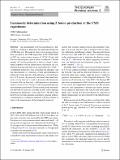| dc.date.accessioned | 2024-01-16T18:06:21Z | |
| dc.date.available | 2024-01-16T18:06:21Z | |
| dc.date.issued | 2024-01-10 | |
| dc.identifier.uri | https://hdl.handle.net/1721.1/153314 | |
| dc.description.abstract | The measurement of Z boson production is presented as a method to determine the integrated luminosity of CMS data sets. The analysis uses proton–proton collision data, recorded by the CMS experiment at the CERN LHC in 2017 at a center-of-mass energy of 13
$$\,\text {Te\hspace{-.08em}V}$$
Te
V
. Events with Z bosons decaying into a pair of muons are selected. The total number of Z bosons produced in a fiducial volume is determined, together with the identification efficiencies and correlations from the same data set, in small intervals of 20
$$\,\text {pb}^{-1}$$
pb
-
1
of integrated luminosity, thus facilitating the efficiency and rate measurement as a function of time and instantaneous luminosity. Using the ratio of the efficiency-corrected numbers of Z bosons, the precisely measured integrated luminosity of one data set is used to determine the luminosity of another. For the first time, a full quantitative uncertainty analysis of the use of Z bosons for the integrated luminosity measurement is performed. The uncertainty in the extrapolation between two data sets, recorded in 2017 at low and high instantaneous luminosity, is less than 0.5%. We show that the Z boson rate measurement constitutes a precise method, complementary to traditional methods, with the potential to improve the measurement of the integrated luminosity. | en_US |
| dc.publisher | Springer Berlin Heidelberg | en_US |
| dc.relation.isversionof | https://doi.org/10.1140/epjc/s10052-023-12268-2 | en_US |
| dc.rights | Creative Commons Attribution | en_US |
| dc.rights.uri | https://creativecommons.org/licenses/by/4.0/ | en_US |
| dc.source | Springer Berlin Heidelberg | en_US |
| dc.title | Luminosity determination using Z boson production at the CMS experiment | en_US |
| dc.type | Article | en_US |
| dc.identifier.citation | The European Physical Journal C. 2024 Jan 10;84(1):26 | en_US |
| dc.contributor.department | Massachusetts Institute of Technology. Department of Physics | |
| dc.identifier.mitlicense | PUBLISHER_CC | |
| dc.eprint.version | Final published version | en_US |
| dc.type.uri | http://purl.org/eprint/type/JournalArticle | en_US |
| eprint.status | http://purl.org/eprint/status/PeerReviewed | en_US |
| dc.date.updated | 2024-01-14T04:12:06Z | |
| dc.language.rfc3066 | en | |
| dc.rights.holder | The Author(s) | |
| dspace.embargo.terms | N | |
| dspace.date.submission | 2024-01-14T04:12:06Z | |
| mit.license | PUBLISHER_CC | |
| mit.metadata.status | Authority Work and Publication Information Needed | en_US |
